If you’re looking to transform the ambiance of your living spaces, changing the color of your travertine tiles can be an excellent way to achieve a fresh and personalized look.
Travertine is a natural stone that possesses timeless beauty, durability, and versatility, making it a popular choice for flooring, countertops, and backsplashes.
Travertine can be stained naturally with water-based dyes that are nontoxic. Another way to change the color of travertine is via chemical treatment. This will change the color of the tile permanently.
Many homeowners prefer to change the color of their travertine tiles to match their individual tastes, even though travertine is available in a variety of colors.
From light ivory to deep chocolate brown, travertine comes in a variety of colors. Even though the color of travertine is striking, it can also be difficult to match with other design elements.
It is possible for the color to fade or become scratched or damaged over time. So, it makes sense that you would want to update your travertine tile or refresh it.
With the right approach, travertine tiles can be altered to change colors. With a little knowledge and effort, you can color the picture the way you like.
We will demonstrate how to change the color of travertine tile using the appropriate products and techniques in this article. Let’s get started.
How to Change Color of Travertine Tile: Different Methods Explained
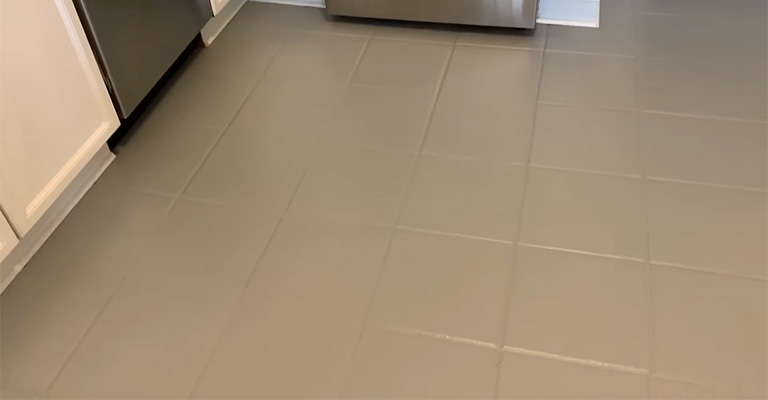
It is possible to change the color of travertine tiles in several ways. One way to achieve this is through chemical treatments.
As a result, the stone’s color will be permanently altered. The stone can also be temporarily darkened using a topical treatment.
In some cases, this method is preferable to others as it is less harsh on the stone and can be easily reversed when necessary.
There are also those who prefer simply painting travertine tiles. While this is a less permanent method, it can help you get the desired effect without drastically altering the stone.
1. Staining Method
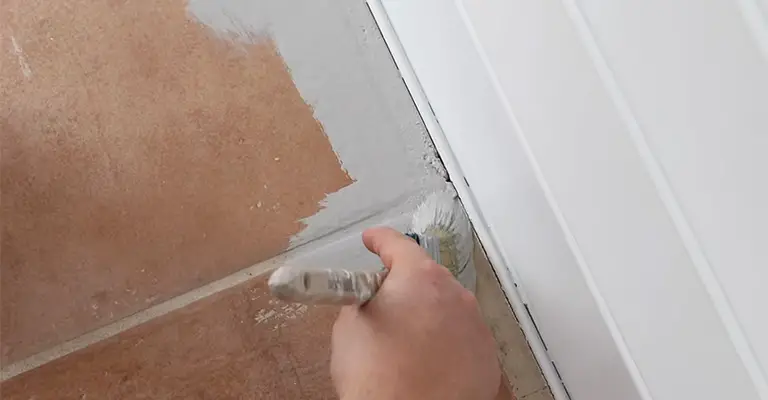
The process of staining travertine tile is relatively simple, albeit time-consuming. Use a whitewash or simple wood stain to make it look good. There is a stain for every color in the rainbow, so it can be darkened, lightened, or brightened.
Prep Before You Stain on Travertine Tile
The area must be cleared before staining can be applied. Don’t pause the process once you’ve started.
You may see irregularities in the shade of stain you are applying. Before working with travertine, turn off all fans and shut vents that would blow air or heat onto it.
The travertine should be thoroughly cleaned before staining and allowed to completely dry. It is possible for harsh cleaners to leave a residue behind.
Mop the travertine tile thoroughly with a bucket of warm water and a few drops of mild dish soap.
Ensure that any areas you don’t want affected by the stain are blocked off. Tape around areas with painter’s tape. Tape down drop cloths or tarps around the edges of carpeting where it meets tile.
Types of Stain to Use on Travertine
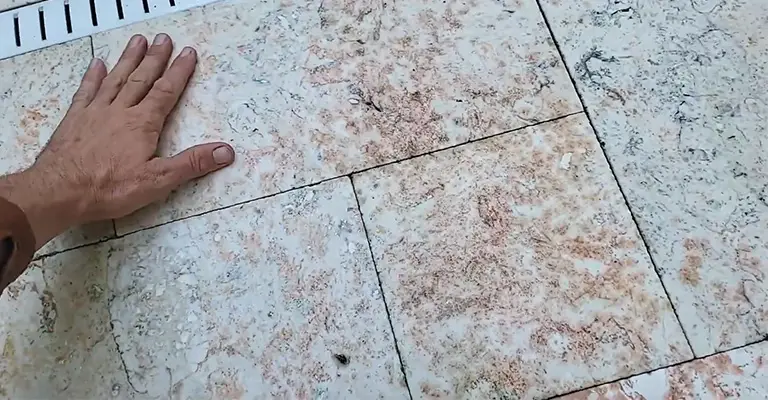
Since travertine’s base is limestone, it is ideal for absorbing most types of stains. Despite high traffic, travertine retains its rustic charm and requires little maintenance.
It is possible to repair travertine quickly and individually when it is cracked or damaged.
One of the easiest ways to change the color of travertine is to apply a wood stain. It is also possible to paint or whitewash them. If you want to protect the stone and stain, seal them.
Paint each tile with a 1:1 mixture of white paint and water to whitewash travertine. To get an even coat, move slowly across the tiles. Ensure that the whitewash is evenly distributed when remixing.
How to Stain Travertine
The tannins in the stain need to be evenly mixed before applying it. Stir a gallon of the stain with a long wooden stick in a bucket twice its size.
Apply the stain directly to the tile with a paintbrush. Start at a corner of the room and work your way to the exit. Wait at least one day for the stain to dry. Add a second coat of paint if you want the travertine to be darker.
2. Painting Method
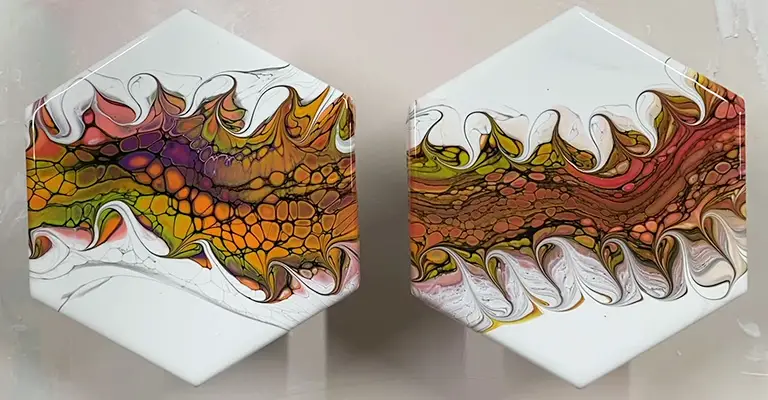
Is it possible to paint travertine tiles? It can be difficult to paint Travertine because it is a porous stone. In spite of this, you can paint travertine tiles successfully if you use the right products and prepare them properly.
It is first necessary to clean and sand the tile surface. Apply a primer designed specifically for porous surfaces next. Two coats of latex paint can be applied after the primer has dried.
3. Whitewash Method
Is it possible to whitewash travertine backsplashes? The first time travertine is installed, it usually looks bright white.
A yellowing or staining can occur as time passes. Whitewashing travertine restores its original color and gives it a fresh, clean appearance.
A few household supplies are needed for the process, which is relatively simple. If any unpleasant material is present on the surface of the travertine, it must be removed.
Mix water and bleach 1:1 to create a whitewashing solution. Using a sponge or brush, the solution is applied to the travertine and allowed to sit for 5-10 minutes.
Following a thorough rinse with clean water, the travertine should be allowed to dry completely. Your travertine will look brighter and more vibrant after this process.
4. Sealing Method
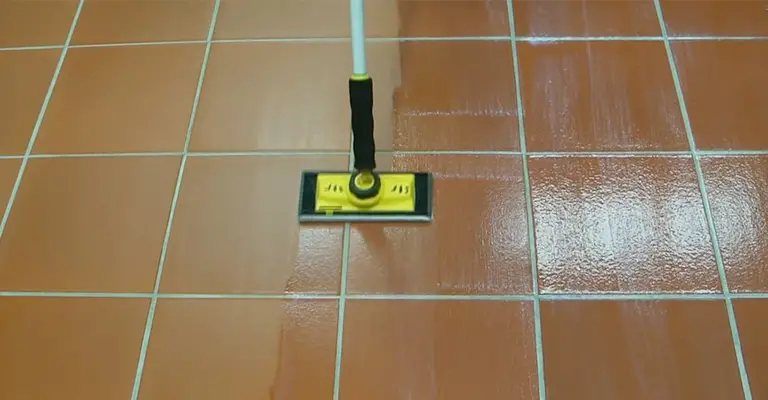
When travertine is sealed, does the color change? Travertine can become stained and lose its shine over time. Protecting and cleaning travertine with sealant can help prevent wear and tear.
Travertine’s color can be dramatically changed by sealing it. Travertine sealed with a coating may appear darker or more vibrant than unsealed stone.
But this is usually a temporary phenomenon that fades with time. Travertine’s appearance is not usually significantly altered by sealing it.
Can you Refinish Travertine Tile?
A smoother surface can be achieved by polishing or honing travertine in its natural state. Refinishing travertine tiles may be an option if yours are beginning to show signs of wear.
Travertine flooring, unlike other types of flooring, can be sanded down and refinished like any other stone.
As this process removes the current finish, you will need to decide whether to refinish the tile in its natural state or reapply a new coat of polish or sealant.
Whether you refinish travertine tile or not, restoring its original beauty can be relatively simple.
To roughen the surface and remove contaminants, the tile is first cleaned and sanded.
The stone sealer is then applied using an applicator. A shine is then achieved by buffing the tile. It only takes a few hours for the whole process to be completed. This will give your travertine tile a new look in no time.
Can You Use Hydrogen Peroxide on Travertine?
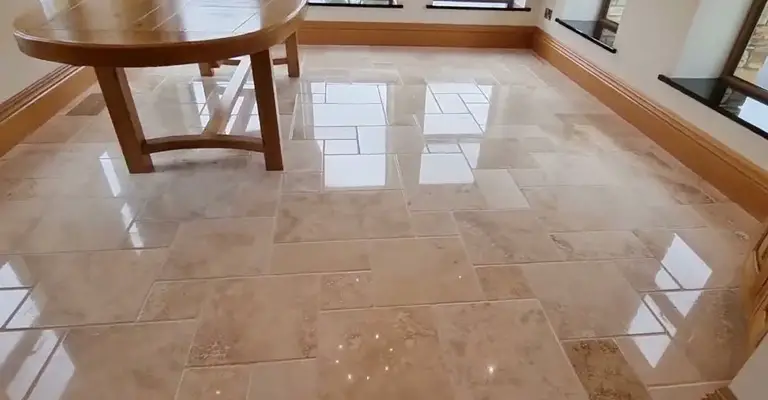
I would say yes! It is possible to clean travertine with a peroxide-based product like Oxiclean, which will not damage its polish.
You can rest assured that hydrogen peroxide will not damage your travertine because it is often used for cleansing and disinfecting wounds. After cleaning, rinse the surface well and follow the instructions on the product.
Can I Bleach Travertine Tile?
Travertine stone is quite porous because it comes from nature. If it is not properly sealed, it may stain. Travertine can be permanently damaged if bleach is used improperly as a cleaning agent.
Therefore, bleach should not be used on travertine tile. You can clean your tile without damaging it with many milder cleaners on the market.
Travertine tiles can always be professionally sealed if you are concerned about stains. As a result, it will be more resistant to stains and easier to clean.
What Color Does Travertine Come In?
A type of limestone, travertine forms as a result of geological activity, usually surrounding hot springs or caves. A porous surface and earthy colors characterize it.
Stones are usually found in tans or creams, but they can also occur in yellows, reds, and grays. During the formation of travertine, impurities affect its color.
Stones can exhibit reddish hues when iron oxides are present, whereas yellowish hues when magnesium is present.
There is a wider range of colors in travertine that contains more impurities. It is also possible to dye stone tiles to achieve the desired effect.
Can You Restore the Original Color of Travertine Tiles by Sanding Them?
The surface of travertine is smooth. In addition to flooring and countertops, it is often used for backsplashes. Over time, it can lose its shine, despite being a durable material.
In these cases, most people think that Travertine must be replaced in order to restore its original appearance.
The reality is that this isn’t always the case. Using a little elbow grease, you can sand down your travertine and make it look like new.
There is a relatively simple process involved. In the beginning, you’ll need a few supplies. In addition to a power sander, you will need sandpaper (coarse and fine) and a vacuum cleaner. Travertine can be sanded down once you have everything you need.
Starting with coarse sandpaper, progress to fine sandpaper. After each sanding session, vacuum up the particles. Travertine can be restored to its original beauty with a little effort.
What Kind of Paint Do You Use on Travertine?
Travertine can be painted with a few different types of paint. Acrylic latex paint is a good option for stone surfaces because it is specifically designed for them.
Epoxy-based paint is another option, which is extremely durable and long-lasting. Travertine can be covered and protected with either of these types of paint.
Additionally, travertine should be primed before painting in order to ensure better paint adhesion. Travertine should also be painted in light coats and allowed to dry completely between each coat.
As a result, the paint will not pool in the porous surface of the travertine and the overall finish will be better.
Can you Paint Travertine Tile in the Shower?
The beauty of travertine tile and its durability make it a popular choice for showers. Travertine tiles are sometimes painted by homeowners.
You can paint your shower travertine tile if you want, but painting is not recommended. Stone sealers or enhancers are one option.
Travertine can be darkened and given a glossy finish with these products. You can also use tile stickers or decals. By adding these add-ons, you can completely transform the look of your shower without having to permanently alter the tile.
As a final option, you might want to consider replacing your shower’s travertine tiles with a completely different type of tile. Before making any major changes to your shower, be sure to consult with a professional.
Can you Paint Travertine Pool Coping?
Tiles made of travertine are commonly used for pool copings, walkways, patios, and other outdoor spaces. Landscapes can be enhanced with this stone’s durability and beautiful veining.
In spite of its low maintenance requirements, travertine will eventually require cleaning and resealing to keep it protected. You may also want to consider painting the stone when resealing it.
Several colors of paint can be used to achieve the desired look on Travertine, and a brush or roller can be used to paint it.
You should use high-quality exterior paint when painting travertine pool coping and follow the manufacturer’s instructions carefully.
Moreover, exposure to sunlight and chlorine may fade the color of painted copings over time.
Factors To Consider When Painting Travertine Tiles
There are a few things to keep in mind when painting travertine tiles.
- A paint color that complements the existing color scheme of travertine is essential since it is a natural material.
- Applying a high-quality primer and paint formulated specifically for stone surfaces is essential.
- Any particles or grime will show through the paint if the tiles are not thoroughly cleaned before painting.
- Utilize long strokes to apply the paint evenly, following the stone’s grain.
- As travertine tiles age, they tend to darken. It may therefore be a good idea to choose a light-colored paint.
- Painting travertine tiles can provide any room in your home with a fresh new look with proper preparation and care.
Final Words
Design professionals and do-it-yourselfers alike continue to choose travertine for their projects.
It is easy to change the color of your travertine in your living spaces if you do not like the current shade. Travertine absorbs stains and pigments very well because of its porous surface.








